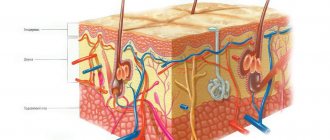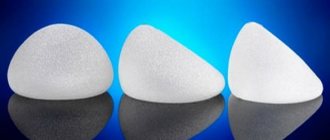Plastic surgeon Eduard Gennadievich Schumacher
- Breast augmentation
- Breast lift
In this article you will receive answers to frequently asked questions about mammoplasty plastic surgery, which is divided into the following types:
- augmentation mammoplasty;
- reduction mammoplasty of the breast;
- mastopexy with and without implants.
Preparation for mammoplasty surgery
Before the operation, you must, first of all, carefully prepare and find out information about all the features of the operation, the recovery period and complications after mammoplasty. In addition to discussing the shape and size of the mammary glands with the surgeon, it is also necessary to jointly decide on the choice of a prosthesis and the location of the incision. The shape of the breast and the location of the sutures after mammoplasty will depend on this. During the consultation, the patient can have implants fitted and visually assess the future breasts. Our clinic cooperates with various implant manufacturers, which allows us to provide patients with a wide range of prostheses for breast augmentation. Prostheses can be round or anatomical in shape; the choice of implant is made by a specialist depending on the desired result and the characteristics of the patient’s breast.
Before breast surgery, you must undergo a number of studies:
- ultrasound examination of the mammary glands;
- general blood analysis;
- general urine analysis;
- blood chemistry;
- testing for HIV, syphilis, hepatitis B and C;
- blood clotting test;
- FLG;
- ECG. Attention! Additionally, consultation with an anesthesiologist and therapist is required.
Mastopexy (breast lift)
This type of mammoplasty in Novosibirsk is a correction of the shape of the mammary glands when they are drooping (ptosis).
The most common causes of breast drooping are: postlactation involution, weight fluctuations, and hereditary factors.
There are 3 main types of mastopexy:
- circum-vertical mastopexy;
- anchor mastopexy;
- areal mastopexy.
The optimal look for a particular patient is determined by a plastic surgeon during a consultation. The decision is made based on the anatomical structure of the body and the wishes of the girl. Mastopexy is often combined with breast augmentation using implants. In some cases, a lift can be combined with lipofilling; this happens if the patient is categorically against implants. Sometimes minor ptosis of the mammary glands is possible without mastopexy; correction is carried out only by installing implants; if this possibility exists, the doctor will definitely offer it at the consultation.
During the initial appointment, the plastic surgeon tells and shows where the stitches will be located and how they can be made less noticeable in the future. The doctor also informs you in detail about the process of preparing for plastic surgery.
How is mastopexy performed?
This breast mammoplasty takes place under general anesthesia and lasts from 1.5 to 3 hours. After the intervention, the patient remains in the hospital for an average of 1-2 days. During this time, examinations and dressings are performed by a plastic surgeon.
Most often, when performing this operation, the doctor applies self-absorbing sutures. A few days after discharge, you need to come back for an examination and dressing to the doctor; for out-of-town patients there are special recommendations that are discussed after the fact.
During the postoperative period, you need to wear compression garments for 1-2 months.
There is a strict 1 month limit on physical activity. 1 year after the intervention, you can plan to conceive a child. A breast lift is not a contraindication for lactation.
The peculiarity of mammoplasty for breast lift is that the final result after the operation is formed in 4-6 months. To maintain the result and shape, it is recommended to constantly wear a bra; you can only be without it for a short time; control and maintenance of body weight is also a key factor.
Performing an operation by a surgeon in our clinic
The operation is performed under general anesthesia and lasts about an hour (60 minutes).
Often, with augmentation mammoplasty using implants, it is necessary to solve additional problems associated with dissatisfaction with the size of the areolas and ptosis of the mammary glands. Depending on this, we choose access tactics, shapes, and sizes of implants, ultimately achieving an aesthetically attractive breast shape. The incision, depending on the structure of the breast, can be made in different places, hence there are several access options, each of them has its own indications:
- Axillary (through the armpit);
- Paraareolar (through the areola of the nipple);
- Submammary (incision in the inframammary fold).
The type of access is determined by the surgeon individually, depending on the client’s preferences and the clinical case.
Augmentation with implants
The most common type of mammoplasty today is the installation of implants.
Depending on the type of endoprosthesis chosen, the final contours and size of the breast vary. The modern market offers a wide variety of types of endoprostheses. They vary in material, shape, density, structure.
- Based on their shape, they are divided into round and anatomical. The latter have a drop-shaped appearance and are aimed at making the bust more natural after surgery. It should be borne in mind that in case of displacement, they may become deformed. With round endoprostheses, this scenario is excluded; in any case, they will retain their original shape. Both can have a low and high profile (different thicknesses).
- Filler. Gel (silicone-based) and saline implants are available on the market. The latter contain saline solution with a salt content of about 0.9%. Saline endoprostheses are softer and breast enlargement with their help costs slightly less. Silicone ones retain their shape better and have greater elasticity. Both fillers are completely safe; if they are damaged, their contents do not spread throughout the body.
- Based on density, they are divided into soft, dense and softtouch implants. The former look more natural, but can change their appearance over time, the latter do not lose it, but look much more artificial, while the latter represent some kind of intermediate solution.
- According to the structure, smooth and embossed ones are distinguished. Textured ones are more stable and less prone to shifting. However, as a result of the interaction of subcutaneous tissues and the endoprosthesis, there is a risk of wrinkles appearing on the skin. With smooth ones, such nuances are excluded, but the likelihood of them being displaced is slightly higher.
Bust enlargement by installing implants can be done in several ways:
- Through an incision in the near-areolar area. The undoubted advantage is that the seam is hardly noticeable as a result.
- Installation of endoprostheses through an incision along the fold under the pectoral muscles. In this case, access for the doctor becomes easier, and the seam is also not too noticeable. The inconvenience can be considered that for some time after the operation the patient will have to wear a protective bandage to prevent the bra from rubbing the suture scar.
- With access through the armpit. It is the most traumatic method of installing implants. The advantages include good fixation of the implant, breast tissue is not affected
Mammoplasty
“For beautiful women who deserve to become a man’s dream!” © AvisMed
Dear women , specialists of the highest level of the AvisMed Children's Center are pleased to invite you to perform an ideal mammoplasty!
One of the most popular plastic surgeries, despite various annual trends, remains mammoplasty . There is no point in citing statistics, much less writing “washed-out” information, which is replete with the entire Internet space related to plastic surgery. The only thing that matters is what the patient who decides to undergo plastic surgery really cares about. And this is not a medical “wild” with ephemeral concepts, but the practical side of the issue, presented in the most comfortable language - which is what is offered to you in this article about breast augmentation.
Let's start with the fact that you decide to enlarge your breasts through plastic surgery .
You are faced with a number of tasks:
1. Find out as much as you can about breast augmentation!
At your disposal are an innumerable number of Internet resources with a huge amount of information - it would seem that everything is great, but! there is a fairly weighty “BUT”: the more a person immerses himself in this “miscellaneous” information, the more confusion arises in his head, and in the end he cannot understand: neither what he really needs, nor whether all this is needed at all. Therefore, to preserve your psycho-emotional state, the most effective way would be to simply cross this item off your list of tasks and move on to the next one.
2. Find a plastic surgeon!
The main thing is to find not the best one (which, by the way, is quite subjective), but your doctor, the one with whom you will have mutual understanding at the very first consultation. Therefore, do not be guided by someone else’s head, other people’s emotions, but only by your own and your intuition.
3. Find the optimal price-quality ratio!
The point is that you receive a service at the highest level for a reasonable price. Good service, attentive and caring attitude, individual approach, high level of professionalism and modern high-quality products - all this is available, but the price range is quite wide. In solving this problem, a pleasant option is the discount seasons of leading clinics, when you can get everything you need from consultation to postoperative rehabilitation with maximum comfort, with the participation of highly qualified specialists, at the best price.
What you need to know about your initial consultation:
At the initial consultation before mammoplasty, you need to tell the doctor about your wishes regarding your new breast:
What shape and volume would you like?
This is necessary so that the plastic surgeon tunes in to your vision. Then a series of measurements are taken, after which we can begin selecting implants for you. You have a choice between round and anatomical implants. The choice of implant type depends on the initial shape and size of the mammary glands , as well as the integumentary tissues - skin and subcutaneous tissue. Once the shape is selected, the volume is selected. At your request, your plastic surgeon implants of various shapes and consistencies.
Discussion of the operation itself.
The most pressing issues are: - access (incision site); — postoperative scars; - anesthesia; — possible complications; - rehabilitation.
Regarding access, everything is quite trivial. There are three types of access:
- under the gland (submammary) – the postoperative scar in this case is located in the fold under the gland (submammary fold) and is practically invisible. This type of access is the least traumatic, so the rehabilitation time is minimal, but, unfortunately, it is not suitable for everyone;
- through the areola (periareolar) – access along the edge of the areola, in this case the scar is located in an arched manner along the lower edge of the areola and its severity directly depends on the individual characteristics of the organism in the formation of scar tissue;
- through the armpit (axillary) - access is made through an incision in the armpit; the scar is located in a natural fold in the armpit and is hardly noticeable, but is still visible when raising the arms. This type of access is the most traumatic - therefore, the rehabilitation course is the longest and most painful.
It is important to note that each type of access has its own indications and the surgeon offers the most favorable option for the patient, but in some cases patients are persistent in their wishes, and the surgeon performs the operation taking into account these wishes, but cannot guarantee achievement highly accurate results. Therefore, when you find yourself in the hands of a professional, listen to his opinion, and you will get the best possible result.
Request a call!
A few words about anesthesia:
Often, patients are absolutely not afraid of the surgical procedure itself and the possible complications associated with it, but when it comes to anesthesia, the patient completely loses his presence of mind.
The reason for this is several factors:
- Remnants of the late 20th century - a time when there was a large shortage of drugs, and anesthesiologists had to use a very limited list, therefore, the use of one drug for even 2 hours led to severe intoxication of the body and, as a result, patients had a very difficult time recovering from anesthesia after surgery . This point also includes the quality of the equipment that was used in the old days.
- There are many films and TV series that play out all sorts of dramas on the operating table.
- And, of course, everyone’s favorite Internet, where far from professional opinions about operations are expressed.
All of the above has given rise to many “horror stories” that have become widespread and generate fears in people’s minds. Of course, the instinct of self-preservation is one of the basic human instincts, and fear as its manifestation is a completely natural reaction of the body to the upcoming intervention. But, a reasonable approach in choosing a doctor and taking into account his professional opinion, as well as choosing a clinic that has everything necessary for your comfort from the initial consultation to the completion of postoperative rehabilitation, will help minimize possible risks and overcome fear.
Possible complications:
The topic of complications is ambiguous: on the one hand, their frequency according to world statistics is very low, but, on the other hand, if they occur, many questions and complaints arise from the patient against the surgeon. To eliminate misunderstandings about the essence of complications, options for eliminating them, as well as deciding who will bear the costs of eliminating their consequences, it is fundamentally important to classify them according to time. To achieve the best understanding, of course, it is necessary to discuss all the questions that interest you in a face-to-face consultation with your doctor. And to create a primary idea of the possible complications and responsibilities of the surgeon and the patient, we suggest using the following diagram and explanations: Let’s dwell on the last two stages: the late and long-term period.
In late complications, the responsibility of the surgeon and the patient is determined by the following: at this stage, everyday rehabilitation occurs, so the main responsibility falls on the patient, who must strictly follow all the surgeon’s recommendations; The surgeon's responsibility at this stage includes infectious complications (wound infection).
Long-term complications regarding augmentation mammoplasty arise due to the fact that there is a foreign body (implant) in the body - each body reacts to it individually, and some patients may experience complications in a period quite distant from the operation.
You can find out all the details regarding each stage from your plastic surgeon .
The following diagram briefly shows the stages of rehabilitation that await you.
Author of the article: plastic surgeon, Lekhner A.V.
Below are the works of our plastic surgeons:
You can pay for mammoplasty surgery in installments
for a period of 6 to 12 months .
For more detailed information about payment options, please contact the administrators!
You can find out about all types of operations on the mammary glands at the AvisMed Children's Center "SERVICES AND PRICES"
Sign up by phone ☎ 227-6-227!
or
Request a call!
We are looking forward to seeing you!







